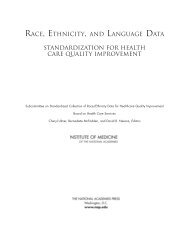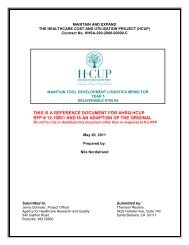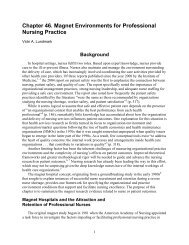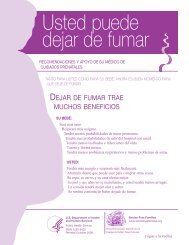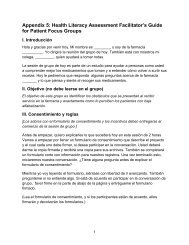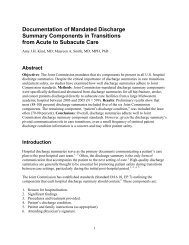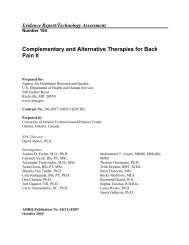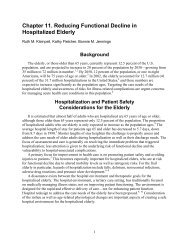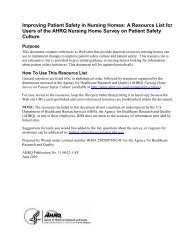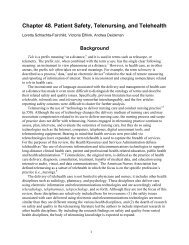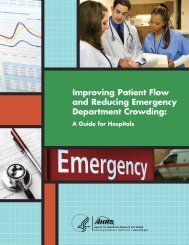Emergency Severity Index (ESI): A Triage Tool for Emergency ...
Emergency Severity Index (ESI): A Triage Tool for Emergency ...
Emergency Severity Index (ESI): A Triage Tool for Emergency ...
Create successful ePaper yourself
Turn your PDF publications into a flip-book with our unique Google optimized e-Paper software.
Vomiting blood or a chief complaint of blood per<br />
rectum should be seriously considered and evaluated<br />
in the context of vital signs. A 30-year-old with<br />
bright red blood per rectum, normal vital signs is<br />
appropriately an emergency but does not warrant an<br />
<strong>ESI</strong> level-2 designation. All five <strong>ESI</strong> levels are<br />
appropriate <strong>for</strong> emergency care within an ED<br />
setting. But the elderly patient who called an<br />
ambulance because he started vomiting blood and<br />
has a heart rate of 117 and a respiratory rate of 24 is<br />
high-risk and does meet <strong>ESI</strong> level-2 criteria.<br />
Cardiovascular<br />
Chest pain is also a very common chief complaint<br />
evaluated in EDs. The presentation of acute<br />
coronary syndromes (ACS) is not always specific,<br />
and it is sometimes difficult to determine the risk of<br />
ACS at triage. Many EDs do not obtain ECGs at<br />
triage. It is important to remember that unless the<br />
ECG is interpreted by a physician prior to the triage<br />
nurse assessment, it will not alter the triage nurse<br />
decision. The mere decision by the triage nurse that<br />
the patient should have an ECG can be interpreted<br />
that the patient meets <strong>ESI</strong> level-2 criteria, high risk<br />
<strong>for</strong> cardiac ischemia. Patients who have an episode<br />
of chest or epigastric discom<strong>for</strong>t, with or without<br />
accompanying symptoms, usually will need an ECG<br />
per<strong>for</strong>med rapidly to determine the presence of ACS<br />
and need to be identified as high-risk <strong>ESI</strong> level 2.<br />
It is also important <strong>for</strong> the triage nurse to<br />
incorporate knowledge of gender differences in the<br />
presentational symptoms characteristic of heart<br />
disease. The 54-year-old obese female who presents<br />
to the ED with epigastric pain and fatigue is at risk<br />
of ACS and should be assigned to <strong>ESI</strong> level 2—highrisk.<br />
Patients with chest pain who are physiologically<br />
unstable and require immediate interventions such<br />
as intubation or hemodynamic support should be<br />
triaged as <strong>ESI</strong> level 1. Not all chest pain patients<br />
meet level-1 or level-2 criteria. For example, a 20year-old<br />
healthy patient with chest pain, normal<br />
oxygen saturation, cough, and fever of 101° is at low<br />
risk <strong>for</strong> ACS and does not meet <strong>ESI</strong> level-1 or level-2<br />
criteria. But, a 20-year-old healthy patient with chest<br />
pain who tells the triage nurse he is using cocaine<br />
should be considered high-risk. Another example of<br />
a patient with chest pain that does not meet <strong>ESI</strong><br />
level-2 criteria would be the patient with recent<br />
upper respiratory symptoms, productive cough with<br />
chest pain, and no other cardiovascular risk factors.<br />
Each patient must be assessed individually. Again,<br />
19<br />
careful listening, vigilance, and experience are<br />
helpful since certain entities including thoracic<br />
aortic dissection can occur from childhood through<br />
adulthood.<br />
Other potentially high-risk cardiovascular situations<br />
include hypertensive crisis, acute vascular arterial<br />
occlusions, and patients who present with a fever<br />
post valve replacement.<br />
Nose and Throat<br />
Patients who are drooling and/or striderous may<br />
have impending airway loss. Although less<br />
common, epiglottitis, a <strong>for</strong>eign body (airway <strong>for</strong>eign<br />
body or esophageal <strong>for</strong>eign body in a child) and<br />
peritonsilar abscess place patients at risk <strong>for</strong> airway<br />
compromise. These are extremely high-risk patients.<br />
Patients with either of these complaints are in<br />
immediate danger of airway compromise and<br />
require immediate intervention. <strong>ESI</strong> level-1 criteria<br />
are met.<br />
When patients with epistaxis present, the triage<br />
nurse should obtain a blood pressure, although this<br />
is not in the <strong>ESI</strong> algorithm. Epistaxis can be caused<br />
by uncontrolled HTN. Several etiologies of epistaxis<br />
represent high-risk situations and include the<br />
following: brisk bleeding secondary to posterior<br />
nose bleed or in the patient using warfarin or other<br />
anti-coagulant. In these situations patients are <strong>ESI</strong><br />
level 2.<br />
Environmental<br />
Patients with inhalation injuries from closed space<br />
smoke inhalation or chemical exposure should<br />
be considered high-risk <strong>for</strong> potential airway<br />
compromise. If the patient presents with significant<br />
airway distress and requires immediate intervention,<br />
they meet level-1 criteria.<br />
Patients with third-degree burns should also be<br />
considered high-risk and be assigned <strong>ESI</strong> level 2. It is<br />
possible that they will require transfer to a burn<br />
center <strong>for</strong> definitive care.<br />
General Medical<br />
Chapter 3. <strong>ESI</strong> Level 2<br />
Several other general medical complaints need to be<br />
considered <strong>for</strong> possible high-risk situations. These<br />
medical complications include:<br />
• Diabetic ketoacidosis<br />
• Hyper- or hypoglycemia



